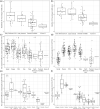Human burials at the Kisese II rockshelter, Tanzania
- PMID: 33615431
- PMCID: PMC8248353
- DOI: 10.1002/ajpa.24253
Human burials at the Kisese II rockshelter, Tanzania
Abstract
Objectives: The Late Pleistocene and early Holocene in eastern Africa are associated with complex evolutionary and demographic processes that contributed to the population variability observed in the region today. However, there are relatively few human skeletal remains from this time period. Here we describe six individuals from the Kisese II rockshelter in Tanzania that were excavated in 1956, present a radiocarbon date for one of the individuals, and compare craniodental morphological diversity among eastern African populations.
Materials and methods: This study used standard biometric analyses to assess the age, sex, and stature of the Kisese II individuals. Eastern African craniodental morphological variation was assessed using measures of dental size and a subset of Howells' cranial measurements for the Kisese II individuals as well as early Holocene, early pastoralist, Pastoral Neolithic, and modern African individuals.
Results: Our results suggest a minimum of six individuals from the Kisese II collections with two adults and four juveniles. While the dating for most of the burials is uncertain, one individual is directly radiocarbon dated to ~7.1 ka indicating that at least one burial is early Holocene in age. Craniodental metric comparisons indicate that the Kisese II individuals extend the amount of human morphological diversity among Holocene eastern Africans.
Conclusions: Our findings contribute to a growing body of evidence that Late Pleistocene and early Holocene eastern Africans exhibited relatively high amounts of morphological diversity. However, the Kisese II individuals suggest morphological similarity at localized sites potentially supporting increased regionalization during the early Holocene.
Keywords: early Holocene; eastern Africa; morphological variation.
© 2021 The Authors. American Journal of Physical Anthropology published by Wiley Periodicals LLC.
Conflict of interest statement
The authors declare no conflicts of interest.
Figures




Similar articles
-
Middle and Later Stone Age chronology of Kisese II rockshelter (UNESCO World Heritage Kondoa Rock-Art Sites), Tanzania.PLoS One. 2018 Feb 28;13(2):e0192029. doi: 10.1371/journal.pone.0192029. eCollection 2018. PLoS One. 2018. PMID: 29489827 Free PMC article.
-
Who were the Nataruk people? Mandibular morphology among late Pleistocene and early Holocene fisher-forager populations of West Turkana (Kenya).J Hum Evol. 2018 Aug;121:235-253. doi: 10.1016/j.jhevol.2018.04.013. Epub 2018 May 29. J Hum Evol. 2018. PMID: 29857967
-
A Late Holocene community burial area: Evidence of diverse mortuary practices in the Western Cape, South Africa.PLoS One. 2020 Apr 16;15(4):e0230391. doi: 10.1371/journal.pone.0230391. eCollection 2020. PLoS One. 2020. PMID: 32298287 Free PMC article.
-
A critical review of the German Paleolithic hominin record.J Hum Evol. 2006 Dec;51(6):551-79. doi: 10.1016/j.jhevol.2006.04.014. Epub 2006 Jul 25. J Hum Evol. 2006. PMID: 17014890 Review.
-
Hunters of the Ice Age: The biology of Upper Paleolithic people.Am J Phys Anthropol. 2008;Suppl 47:70-99. doi: 10.1002/ajpa.20950. Am J Phys Anthropol. 2008. PMID: 19003886 Review.
References
-
- Acsadi, G. , & Nemeskeri, J. (1970). History of human life span and mortality. Hungarian Academic Society.
-
- Ambrose, S. (2001). East African Neolithic. In Peregrine P. & Ember M. (Eds.), Encyclopedia of Prehistory (pp. 97–109). Springer.
-
- Ambrose, S. H. (1986). Stable carbon and nitrogen isotope analysis of human and animal diet in Africa. Journal of Human Evolution, 15(8), 707–731.
-
- Angel, J. L. , Phenice, T. W. , Robbins, L. H. , & Lynch, B. M. (1980). Late stone‐age fisherman of Lothagam, Kenya (Vol. 2). Michigan State University.
-
- Arthur, J. W. , Curtis, M. C. , Arthur, K. J. W. , Coltorti, M. , Pieruccini, P. , Lesur, J. , Fuller, D. , Lucas, L. , Conyers, L. , Stock, J. , Stretton, S. , & Tykot, R. H. (2019). The transition from hunting–gathering to food production in the Gamo highlands of Southern Ethiopia. African Archaeological Review, 36, 1–61.
Publication types
MeSH terms
LinkOut - more resources
Full Text Sources
Other Literature Sources

